With the right representation of the data, this can be done with
cluster analysis. Since you do not provide data, I will illustrate
with the data used on the kde2d help page - the geyser data.
This data is gives a pretty clean separation of "high density"
areas (like your example pictures), so I will just use a simple
k-means clustering.
library(MASS)
attach(geyser)
f2 <- kde2d(duration, waiting, n = 50, lims = c(0.5, 6, 40, 100),
h = c(width.SJ(duration), width.SJ(waiting)) )
image(f2, zlim = c(0, 0.05))

We need to find the "hot spots". In order to get an idea about
what values should be considered "high", we can look at a boxplot.
boxplot(as.vector(f2$z))

Based on this, I will somewhat arbitrarily use points where the
z-value is greater than 0.012. You will need to tune this for
your particular problem.
Hot = which(f2$z > 0.012, arr.ind = TRUE)
HotPoints = data.frame(x=f2$x[Hot[,1]], y=f2$y[Hot[,2]])
plot(HotPoints, pch=20, xlim = c(0.5,6), ylim = c(40,100))

Now we need to cluster the points and find the x & y ranges
for the clusters. First I do it simply and show that the
results are reasonable.
KM3 = kmeans(scale(HotPoints), 3)
plot(HotPoints, pch=20, xlim = c(0.5,6), ylim = c(40,100))
for(i in 1:3) {
Rx = range(HotPoints[KM3$cluster == i,1])
Ry = range(HotPoints[KM3$cluster == i,2])
polygon(c(Rx, rev(Rx)), rep(Ry, each=2))
}

I am not sure how you want the results presented to you,
but one way to get them all in one place is this:
XRanges = sapply(unique(KM3$cluster),
function(i) range(HotPoints[KM3$cluster == i,1]))
XRanges
[,1] [,2] [,3]
[1,] 3.979592 3.867347 1.734694
[2,] 4.877551 4.316327 2.071429
YRanges = sapply(unique(KM3$cluster),
function(i) range(HotPoints[KM3$cluster == i,2]))
YRanges
[,1] [,2] [,3]
[1,] 47.34694 70.61224 73.06122
[2,] 62.04082 87.75510 95.10204
This gives a min and max for x and y for each of the three clusters.
However, I made a few choices here and I wish to point out
that I still left some work for you. What you still need to do:
1. You need to choose a cut-off point for how high the density
needs to be to get a cluster.
2. Given the points above your cut-off, you will need to say
how many clusters you want to generate.
The rest of the machinery is there.



